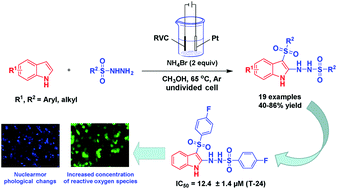Electrochemically enabled chemoselective sulfonylation and hydrazination of indoles†
Abstract
Environmentally benign electrochemically enabled chemoselective sulfonylation and hydrazination of C2,C3-unsubstituted indoles with arylsulfonyl hydrazide in the presence of ammonium bromide as a redox catalyst and electrolyte have been demonstrated in this work. Under mild electro-oxidation conditions, a series of indole hydrazination products with pharmacological activity were obtained. In vitro, the hydrazination products exhibited a better anti-cancer activity compared with the diazotization products. Further mechanistic studies showed that compound 3ae inhibits cell migration and tubulin aggregation in T-24 cells, thereby leading to cell apoptosis.



 Please wait while we load your content...
Please wait while we load your content...